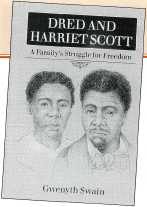 |
Home | Search | Browse | About IPO | Staff | Links |
 |
Home | Search | Browse | About IPO | Staff | Links |
|
An appeal for freedom Dred and Harriet Scott: A Family's Struggle for Freedom  In the Dred Scott decision of 1857, the U.S. Supreme Court ruled that merely living in a state where slavery was prohibited did not free a slave and, further, no blacks—neither slaves nor free men—could claim the rights of United States citizens. At first glance, a book about a court case may not sound very inviting to young readers, but Gwenyth Swain cleverly turns it into a story about Dred Scott's appeal for his family's freedom. Reliable information about Dred is scarce. He was born probably in 1803, probably in Virginia. Slaves took the surname of their master so it is likely that Dred's mother belonged to Mary Scott Blow, the mother of his first owner, Peter Blow. Blow owned a small piece of land and a mere handful of slaves; and unhappy as a minor aristocrat, in 1818 he headed west to seek his fortune. When his attempt to start a cotton plantation in Alabama failed, he turned to inn-keeping, first in Florence, Alabama, then in St. Louis, Missouri. Along the way, it seems, he sold some of his slaves. Dred stayed with the Blow family because, although once a house slave, he adapted to fieldwork and the chores of running an inn. In the early 1830s, Dred was sold to army surgeon John Emerson, who took him to Fort Armstrong in Rock Island, Illinois. Illinois was a free state: slavery was forbidden there. Yet, with the excuse that labor was scarce on the frontier, the army allowed officers to bring slaves and, in order to circumvent legalities, simply referred to them as servants. In 1836, Emerson was transferred to Fort Snelling in Wisconsin Territory, also a free land, where Dred married another army officer's slave named Harriet. Emerson purchased Harriet and he himself married soon afterward, but the army continued to transfer him from post to post. Occasionally he took Dred with him; more often he left his slaves with his bride in St. Louis and hired them out. When he died in 1843, he left Dred, Harriet, and their little daughter to his widow. Three years later, when Dred and Harriet had a second daughter, they filed suit for their freedom on the grounds they had been transported into free territory. As an explanation for this bold move, Swain suggests that they feared the widow would sell the children and break up the family. The Scotts, moreover, had reason to believe they would win the case since other slaves in similar circumstances had been freed. But the case dragged on, through a series of trials and appeals, for eleven years until the U.S. Supreme Court pronounced the final decision: Scott was a slave. Period. By this time, however, Mrs. Emerson had found a second husband, an anti-slavery Congressman from Massachusetts. When the embarrassing case made the headlines, she immediately transferred ownership of the Scotts to Taylor Blow, the son of Dred's first owner, who set them free. In general, Swain's writing is appropriate for junior high school readers. With an adult's guidance, younger readers too can manage the book. Swain also does a fairly good job of turning a complicated historical incident into a story, although her interpretations of the characters' motivations are not always convincing. She might, however, be more explicit about the ways in which Dred's life as a slave runs counter to the Southern plantation stereotype. As Swain implies, particularly on the frontier, blacks and whites worked side-by-side and developed close—if unequal—relationships. The Blow boys who grew up with Dred helped him to pay court costs and secure legal advice, and Taylor Blow ultimately freed the Scott family. While the Dred Scott case remains a shameful moment in our nation's history the story of the man Dred Scott illustrates that friendship between blacks and whites could and did exist in antebellum America. An ironic twist of fate had freed the Scott family, but it took two constitutional amendments to abolish slavery and guarantee the rights of black Americans. Melody Herr is an historian and writer living in DeKalb. ILLINOIS HERITAGE| 25 |
|
|